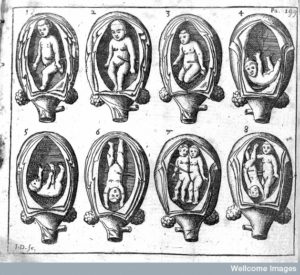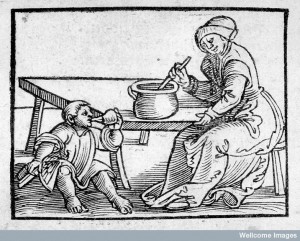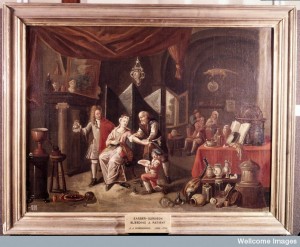
As we saw in the last post John Evelyn’s Kalendarium contains many references to health and sickness, both his own and his family members. His diary entries, written after the event from notes, show that he had a keen interest in medical science throughout his life. When he was first in Italy at Padua he commissioned the production of a series of anatomical illustrations that he later donated to the Royal Society. His writings also give us a brief insight into what it was like to be a spectator of surgical operations.

Credit: Wellcome Library, London.
As is well-known, surgery in the early modern era was a rather daunting prospect – conducted without anesthesia or antiseptics – most procedures were dangerous and painful. Many people therefore avoided surgery as much as possible. Evelyn’s own brother who suffered horrendous pain as a result of a bladder stone (you can find out more about this condition here) was according to John – “all along averse from being cut”. His brother’s refusal to be operated on must have caused some consternation, as Evelyn tried to persuade him it was his best option. On the 10 June 1669 he went to London “to carry My. Pepys to my Bro[ther]: (now exceedingly afflicted with the Stone in the bladder) who himselfe had ben successfully cut; & carried the Stone (which was as big as a tenis-ball) to shew him, and encourage his resolution to go thro the operation”. Calling on the now famous Samuel Pepys, who celebrated his survival of the operation every year was a daring move. This plan was nearly successful as in March 1670 the operation was all set to go ahead until his “spirit & resultion failed”. Sadly for John his brother died two days after he refused to go through with the surgery. John lamented “It pleased God, to deliver him out of this miserable life, towards five this moneday morning, to my unspeakable griefe & sorrow, being a Bro[ther]: whom I most dearly loved”.
Evelyn probably did not promote the idea of this surgery lightly. Twenty years earlier he had witnessed lithotomy operations. He recorded that
at the Hospital of the Charitie, I saw the whole opeartion of Lithotomie namely 5 cut of the stone: There was one person of 40 years old had a stone taken out of him, bigger than a turkys Egg: The manner thus: The sick creature was strip’dto his shirt, & bound armes & thighs to an high Chaire, 2 men holding his shoulders fast down: then the Chirurgeon with a crooked Instrument prob’d till he hit on the stone, then without stirring the probe which had a small channell in it, for the Edge of the Lancet to run in, without wounding any other part, he made Incision thro the Scrotum about an Inch in length, then he put in his forefingers to get the Stone as neere the orifice of the wound as he could, then with another Instrument like a cranes neck he pull’d it out with incredible torture to the Patient, especially at his after raking so unmercifully up & downe the bladder with a 3[r]d Instrument, to find any other Stones that may possibly be left behind: The effusion of blood is greate. Then the patient carried to bed, & dress’d with a silver pipe accommoodated to the origice for the urine to passe
Evelyn returned time and again to the fortitude of patients undergoing these torturous operations. In this case we get the sense that the patient suffered greatly. But this tale was immediately followed by one documenting the same operation of a 8 or 9-year-old child. In this case Evelyn explained that the boy expressed “much cherefullnesse, going through the operation with extraordinary patience, & expressing greate joy, when he saw the stone was drawn”. The cynic in me thinks that forbearance and stoicism were emphasised in these cases because perhaps it was too horrific to acknowledge the pain and suffering this poor child experienced.
Evidently though it was not just the patients themselves who needed a stiff upper lip. Writing in 1672 it becomes clear that Evelyn struggled to watch some surgeries, in this case the amputation of a gangrenous leg, and at this point vowed he would watch no more. He explained that he dined with Mr Cox in the evening after an eventful day,
having seene that morning my chirurgeon cut off a poore creaturs Leg, a little under the knee, first cutting the living & untainted flesh above the Gangreene with a sharp Knife, and the sawing off the bone in an instant; then with searing & stoopes stanching the blood, which issued aboundantly; the stout & gallant man, enduring it with incredible patience, & that without being bound to his chaire, as is usual in such painefull operations, or hardly making a face [or crying oh]: I had hardly courage enough to be present, nor could I endure to se[e] any more such cruel operations.
He explained why he had found this particular case so distressing. The gangrene was not cured and the ‘stout’ man was eventually subjected to a second amputation, which cost him his life. The smell was also particularly notable. He claimed that he did “not remember that ever in my life I smelt so intollerable a stink as what issu’d from the part was cut off, & which I ordered should immediately be buried in the Garden”.
More than this, though, it was the way in which the gallant man had come to be on the operating table that really troubled Evelyn. He sadly recalled that ‘This stout man, was but a common sailer” and criticised the “avarice, anger, and ambition of Princes … who might be happier with halfe they possesse” that led decent ordinary men into battles that inevitably resulted in injury, and in some cases death. Now of course Evelyn’s diary is designed to present him in a particular was as a Godly and learned man. We might also guess from these cases that he either was, or wanted to be seen as, a caring, sympathetic man. Whatever the purpose of these stories was supposed to be it allows us to understand firstly that people unconnected to the patient might be witnesses to surgical operations, and secondly that spectating at such an event was not always an easy matter of medical curiosity. It could be a challenging thing to watch such ‘cruel operations’.
For another case of surgical spectating head over to the Many Headed Monster where Brodie Waddell looks at a similar occurrance in Norwich




Great post, Jen. I came across another case of public surgery, this one in late seventeenth century Norwich. In the record I found, the practice of surgery as spectacle comes comes across as something that was fairly routine and subject to light oversight by the civic authorities:
https://manyheadedmonster.wordpress.com/2012/09/20/norwich-entertainments-part-iv-surgeons-on-stage/
Thanks Brodie
Yes I think it was fairly routine, but perhaps not too comfortable for people. Do you mind if I add a link to this into my blog post?
Of course. Many thanks for the link!